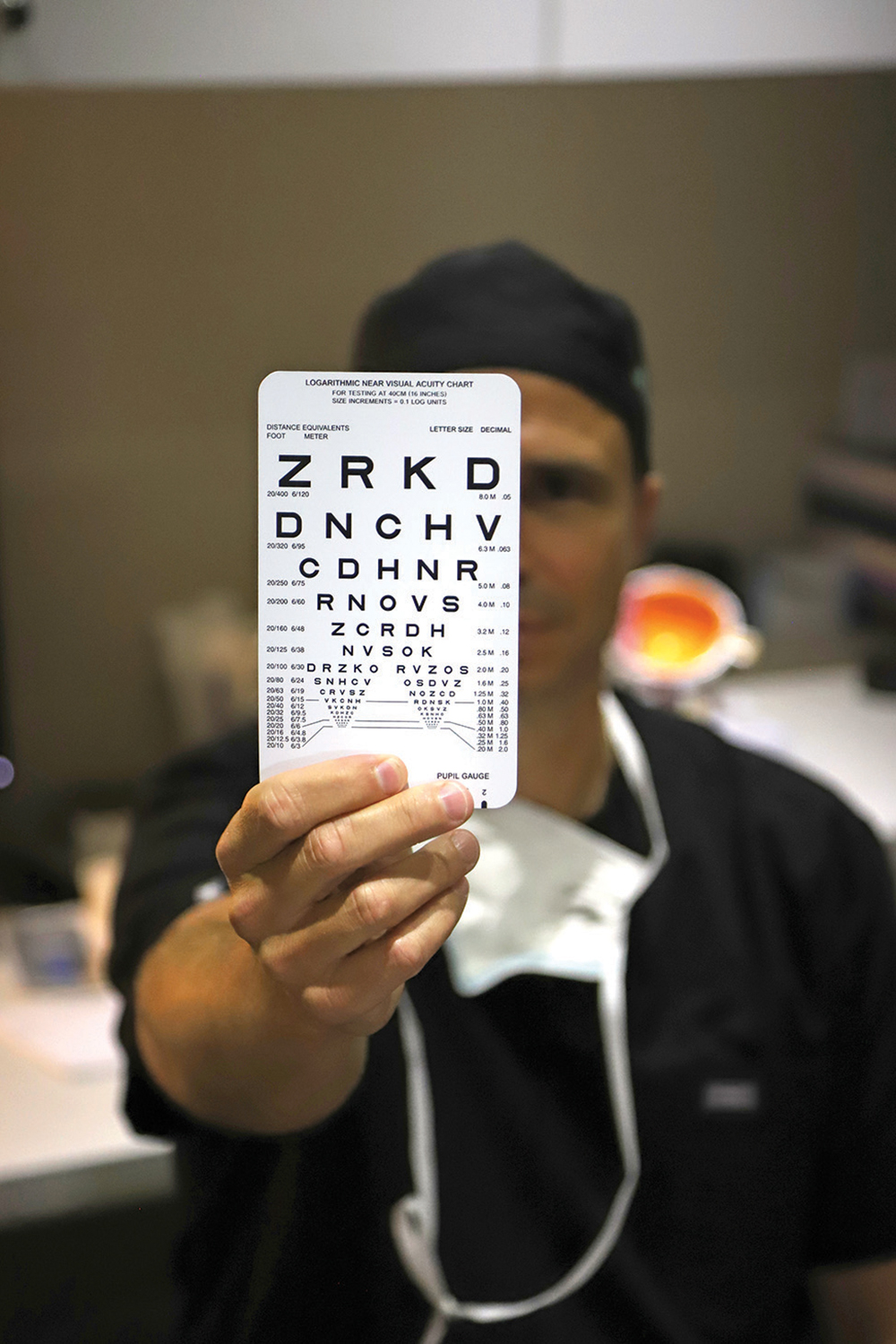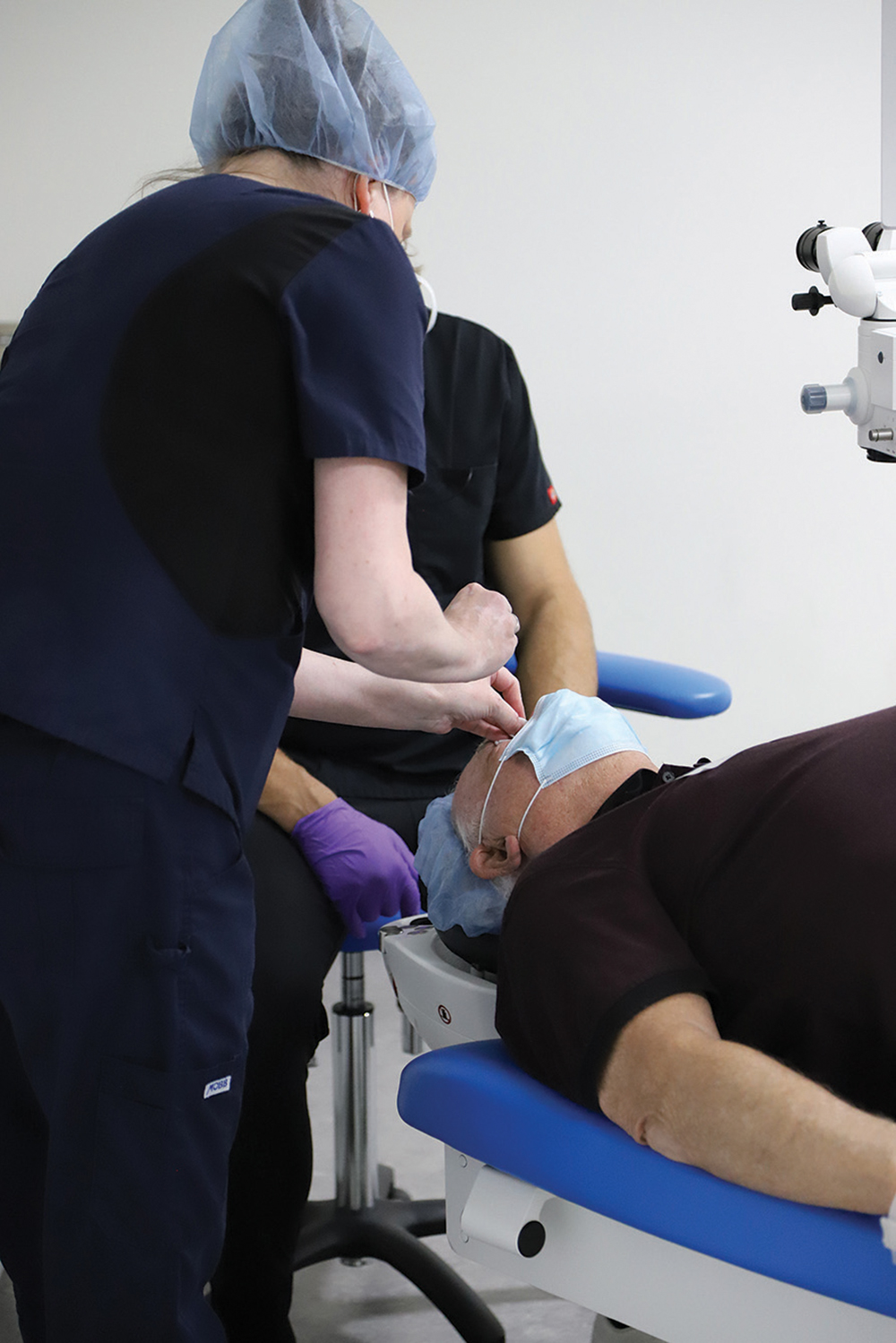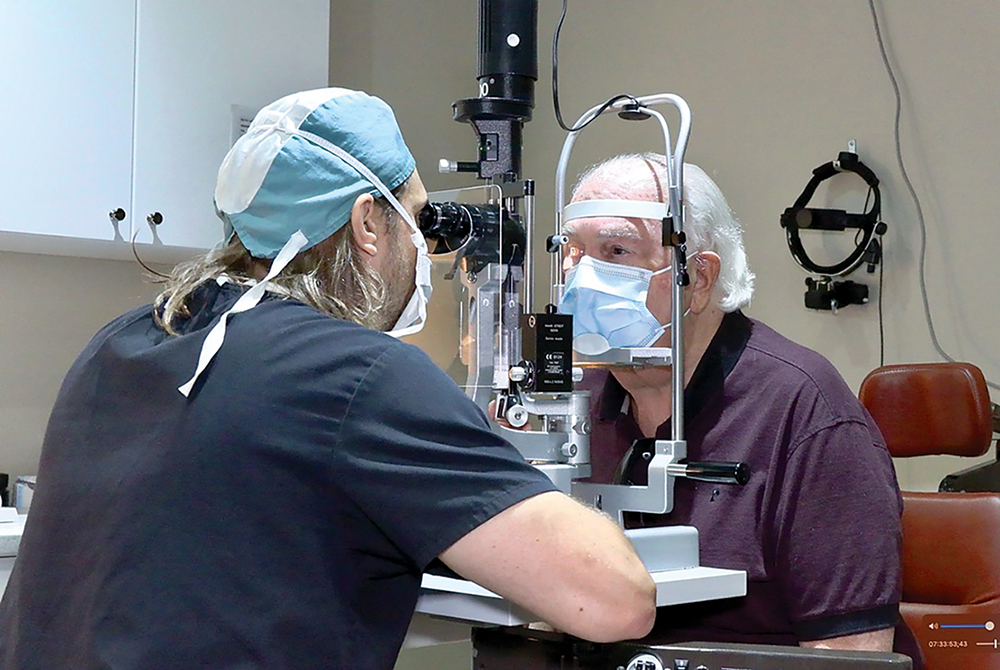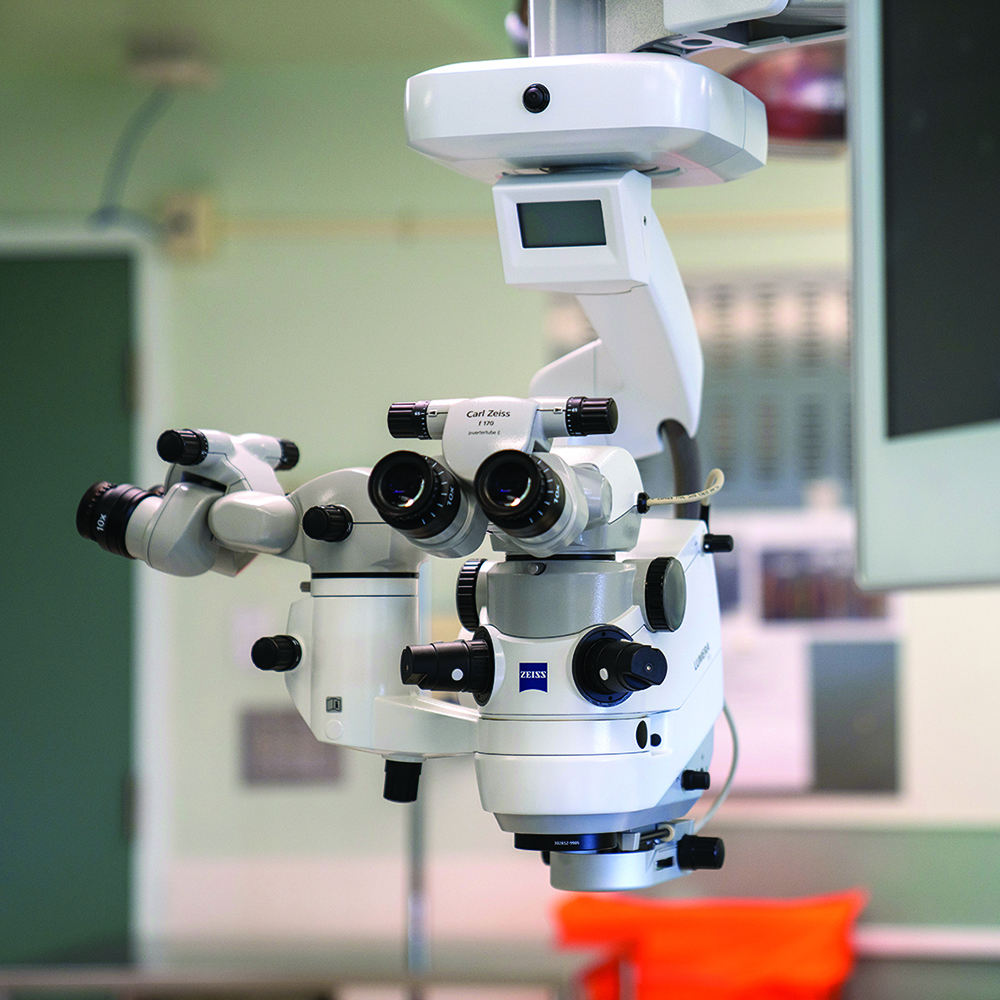Cataract surgery gives patients more than just their vision back; it changes their lives. A good-news healthcare story that’s only getting better.
by Jessica Wortsman // photo By Anya Shor
Last April, when 77-year-old Paul Routley’s vision became so blurry he could no longer see well enough to drive, a visit to his optometrist confirmed a cataract in his left eye.
Routley and his wife were both fighting cancer which required frequent trips to Newmarket for treatment. With him no longer able to drive, getting themselves there became both costly and difficult to arrange.
“You don’t know until you lose your eyesight, the impact it’s going to have on your life,” he says. “You can’t read, you can’t drive, you’ve got to watch where you walk. It stops just about everything.”
Luckily for Routley, cataracts can be treated.
Cataract surgery is a success story worth celebrating in these days when most healthcare stories are ones of pandemic and crisis. The results are, quite literally, a miracle. And with technological advances and new facilities opening nearby, this treatment is only getting better and more accessible. The days of super vision may not be far off.
For Colleen Reid, losing her vision became a matter of safety. Reid, an avid golfer and pickleball player of nearly 80, was diagnosed with cataracts almost three years ago but COVID-19 shutdowns meant that elective surgeries like hers were being postponed. As Reid waited, her vision continued to deteriorate. Between January and March 2022, she suffered seven falls. Looking at a photo of her after one of these falls, it’s difficult to recognize her. In it, she has a black eye, a split lip and severe bruising and swelling of her chin and neck. And that wasn’t even her most serious fall. This past spring, Reid tripped and smashed her face into her linen cupboard, sustaining a concussion.
It’s these sorts of incidents that worry Dr. Norman Mainville, chief of ophthalmology at Grey Bruce Health Services (GBHS).
“For elderly patients with mobility issues, there are significant hazards around if you can’t see well,” he explains. A trip or fall caused by not being able to see a step or a rug becomes especially dangerous for the elderly, for whom recovery from something like a hip fracture can be difficult.
A Closer Look
The human eye has within it a lens that allows us to focus incoming light on the retina to see things both near and far. As we age, along with other factors, our lenses can become cloudy. This is a cataract. Often, this cloudiness gets worse, and our vision becomes impaired.
Over 65 million people worldwide suffer from vision impairment due to cataracts, 20 million of whom are left blind. It is the leading cause of blindness.
When asked how many of her patients she diagnoses with cataracts, Dr. Jayne Cation of Collingwood Optometry replied, “One hundred percent, if they live long enough. Cataracts can be thought of like wrinkles and gray hair—they’re inevitable.”
Clear Cut
We’ve been treating cataracts through various methods since the ancient Egyptians. Though innovations in technique and technology have revolutionized the process, it remains one of the oldest and most common eye procedures performed worldwide. Each year, over 350,000 of them are carried out in Canada alone.
The procedure involves removing the clouded lens through a small incision in the cornea and replacing it with a clear artificial lens. Sometimes this is done by hand, sometimes with the assistance of laser technology.
The most exciting developments these days are happening with lens technology. Premium lenses, like toric and multifocal, can correct common conditions like astigmatism, myopia and presbyopia, often eliminating or minimizing the need for glasses. They don’t come cheap, though, and some of the more specialized ones can cost up to $4,000 per lens. But cost aside, the technology just keeps getting better. There are lenses that improve night vision, others that increase range of focus, others still that can be customized to your liking after surgery. Could X-ray vision be next? Maybe Superman should step aside.
Of course, not everyone is a candidate for these premium lenses and, quite honestly, not everyone can afford them, but many cataract patients now have the option not only to restore their vision but also to improve it.
Waiting On a Miracle
In Ontario, cataract surgery is covered under OHIP. The coverage includes only a standard monofocal lens of your physician’s choosing. If upgrading is an option, you can pay for a premium lens. In most cases, this costs patients less than a couple hundred dollars per eye. It’s a great deal, but to get it, you have to wait in line. And the line is long.
One of the most devastating ways the pandemic disrupted the healthcare system was by causing the deferral of millions of elective surgeries. Hospital overcapacity and staffing shortages have exacerbated the situation, causing a surgical backlog that some experts surmise will take years to clear. Cataract surgery has been hard hit. The wait time for this elective procedure currently ranges between seven months to a year at some regional hospitals.
Locally, GBHS is hoping to counteract this backlog with a newly opened cataract surgery suite at the Meaford Hospital. The state-of-the-art facility was made possible through donations to the Meaford Hospital Foundation and will allow them to increase their service by an additional 1,000 cataract surgeries per year.
The alternative is having a premium cataract surgery done at a private clinic. With this option, there’s no waiting, but there is a bill. And it can be hefty. Prices can range between $1,500 to $4,000 per eye.
Private eye facilities have also been called in to relieve some of the burden on hospitals. Mark Recine is the chief operating officer of Barrie LASIK Centre, a division of the Windsor Laser Eye Institute (WLEI). He says WLEI’s family of five surgical eye centres are currently assisting three regional hospitals with their elective cataract program.
Governments across Canada are pushing to continue the redistribution of the surgical backlog to private clinics.
Though some worry how this plan will affect the healthcare system in the long-term, others see it as the only immediate solution to get people into surgery faster.
Time is an issue. Not everyone has the time to wait, least of all, seniors.
I Can See Clearly Now
For Paul Routley, the choice between adding himself to the OHIP waitlist, which was well over a year long at that point, or having his cataract surgery done at a private clinic, was a no-brainer.
“I don’t know if we could have stood waiting for a year and a half to get the thing done.”
Routley contacted Barrie LASIK, and within a couple of weeks, his cataract had been corrected. He was thrilled with the result. In fact, the vision in his left eye was so improved that he immediately noticed the cloudiness in his right eye and later had it corrected as well.
“I came out of the surgical room, and all of a sudden I can see with two eyes,” he reports after his second surgery. “It changes everything.”
This past spring, Colleen Reid finally got the call and was able to experience the wonder of cataract surgery for herself. She told her surgeon, Dr. Dustin Curts of Owen Sound (who, incidentally, also works with Barrie LASIK), “I don’t know how much time I have left, so I want the best lenses you have.”
Reid says she could already see a difference on the car ride home. “It was phenomenal. I couldn’t believe it. I don’t need glasses at all.”
Whomever you speak with will tell you the same thing—“It’s a miracle, I can see again.” But Dr. Cation warns, “No two people will experience the same results after cataract surgery, so don’t expect the same results as your spouse, best friend or cousin. Vision can be very subjective and 20/20 doesn’t mean the same to everybody.” That being said, she admits that the majority of her patients experience extremely positive results.
Cataract surgery gives you more than just your vision back, it changes your life. Every eye care specialist we spoke with had stories to share. Such as the one about the 93-year-old woman who changed her mind about moving into assisted living after her cataract surgery, because she could see well enough again to manage in her own home. Or the long-term care patient with advanced cataracts who was notoriously combative with nursing staff but who became happy and cooperative after her surgery. There’s the patient that came in blind in the morning and was reading the newspaper by the afternoon.
Then there’s Paul Routley, who’s back behind the wheel.
And Colleen Reid, who’s steady on her feet and out on the golf course.
For all of them, the sun is brighter, colours more vibrant. As Dr. Mainville tells his patients after surgery, “This is how you used to see the world.”
Wherever you get it done, however long you have to wait, at least you know for damn sure it’ll be worth it.

The procedure involves removing the clouded lens through a small incision in the cornea and replacing it with a clear artificial lens.
How to Care for Your Eyes
- Wear sunglasses. Exposure to UV rays can speed up the development of cataracts.
- Keep your vices in check. Along with a myriad of other conditions, smoking and alcohol consumption increase your risk of developing cataracts.
- Enrich your diet. Antioxidant-rich foods and omega-3 fatty acids can help reduce the risk of developing cataracts. Supplements won’t cut it, so do your best to add as many richly coloured fruits and vegetables, along with oily fish like salmon and sardines, into your diet.
- Manage your diabetes. High glucose levels can damage your eyes.
- Get regular eye exams. In Ontario, OHIP covers annual eye exams for those under age 19 and over 65. Those with specific eye conditions (like glaucoma, retinal disease and diabetes) are covered for annual exams as well.




















